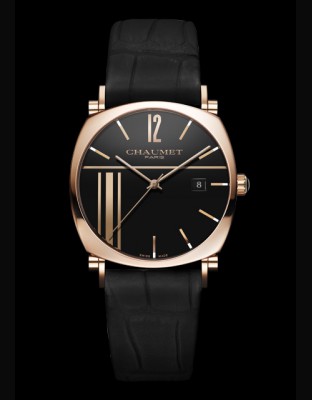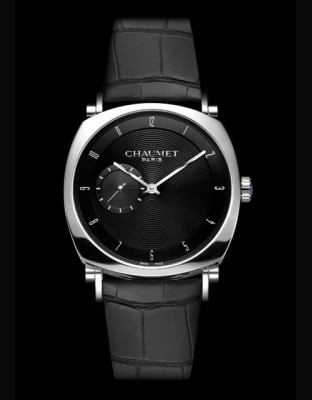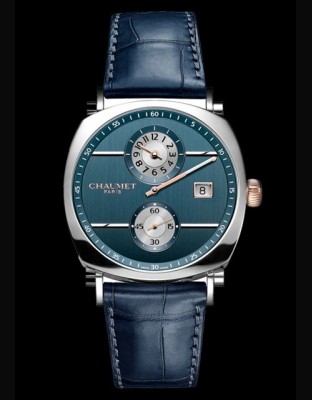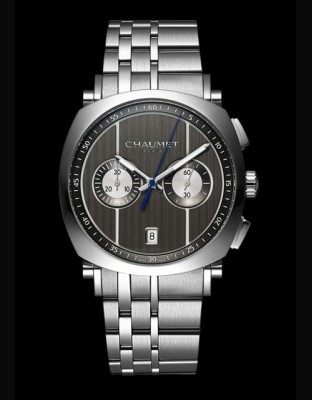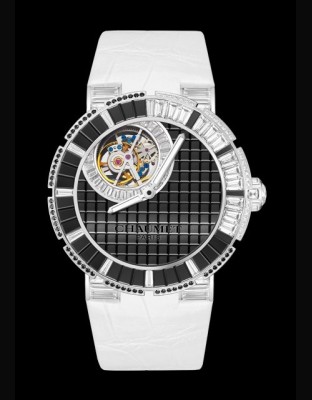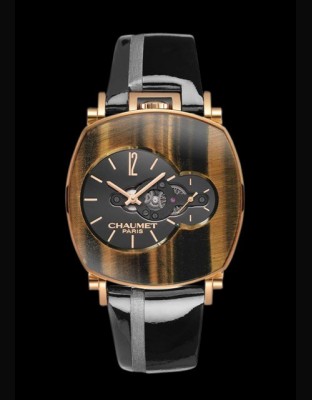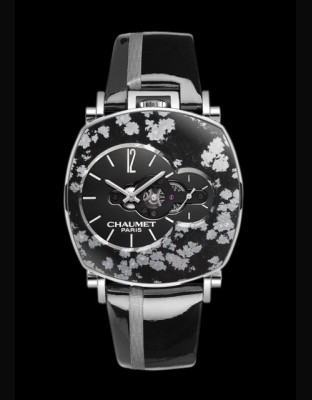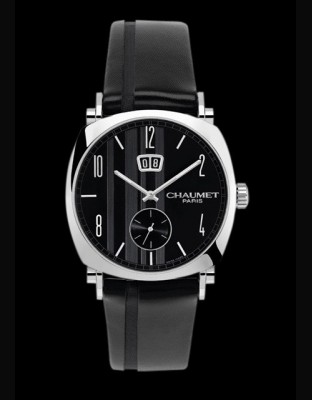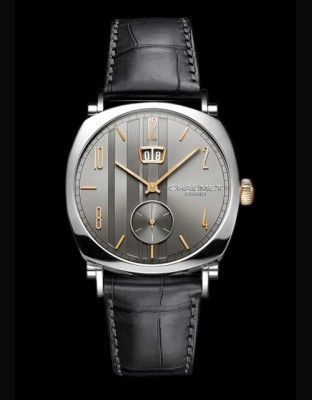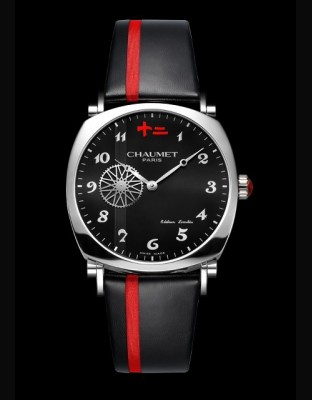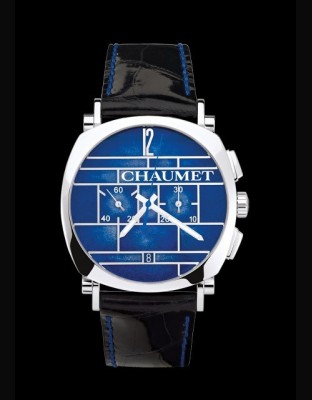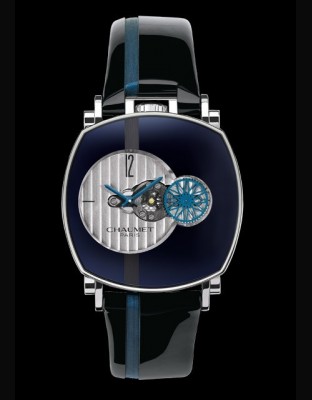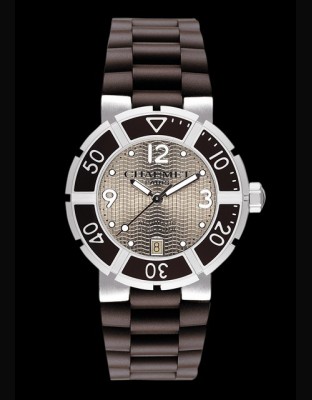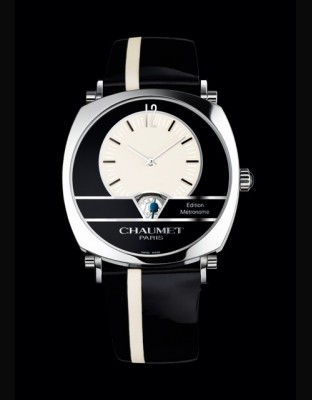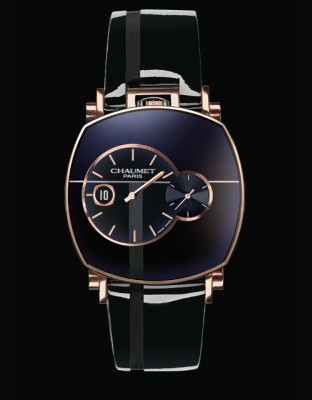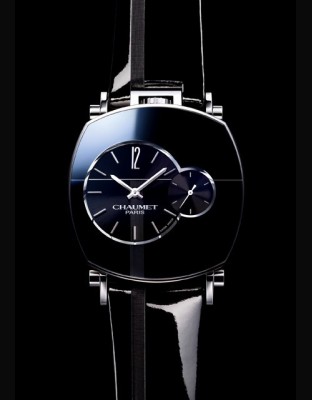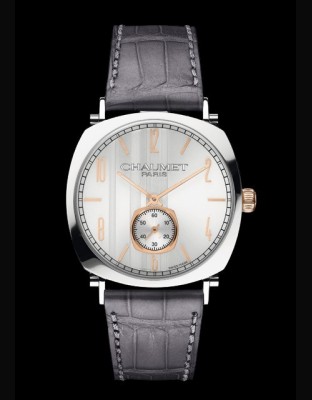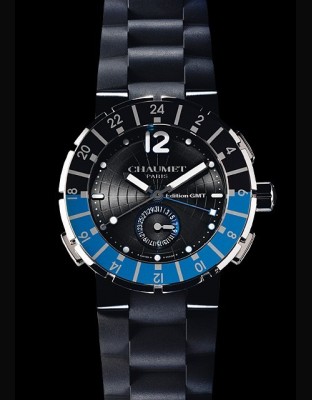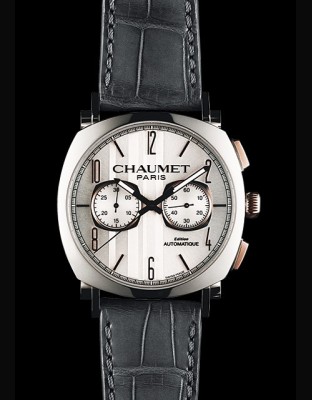
|
||
Chaumet history
Nitot, the founder : Jeweller to Napoleon (1780-1814).
Marie-Etienne Nitot, Chaumet's founder, who had worked with Auber, jeweller to Queen Marie-Antoinette, quickly built up an aristocratic clientele after opening his own shop.
From 1802 onwards he gained his reputation by becoming Napoleon's personal jeweller. Napoleon's taste for jewels was political : they were symbols of the power and exuberance of the Empire period. Nitot design the consular sword, set with the most beautiful royal French diamonds including the famous ...

THE COLLECTIONS

-
-
-
-
-
Chronographe Dandy
SEE THE DATA SHEETBrand: Chaumet
Collection: Dandy
Ref: W11691-49A
Price: 5 350 € -
Class One Tourbillon
SEE THE DATA SHEETBrand: Chaumet
Collection: Class One
Ref: W17191-42A
Price: ON REQUEST -
Class One Tourbillon
SEE THE DATA SHEETBrand: Chaumet
Collection: Class One
Ref: W17192-42B
Price: ON REQUEST -
Class One Tourbillon
SEE THE DATA SHEETBrand: Chaumet
Collection: Class One
Ref: W17194-42D
Price: ON REQUEST -
Class One Tourbillon
SEE THE DATA SHEETBrand: Chaumet
Collection: Class One
Ref: W17193-42C
Price: ON REQUEST -
Dandy Arty Open Face Oeil...
SEE THE DATA SHEETBrand: Chaumet
Collection: Dandy
Ref: W18293-40F
Price: ON REQUEST -
Dandy Arty Open Face...
SEE THE DATA SHEETBrand: Chaumet
Collection: Dandy
Ref: W18293-40E
Price: ON REQUEST -
Dandy Grande Date
SEE THE DATA SHEETBrand: Chaumet
Collection: Dandy
Ref: W11283-47A
Price: 4 600 € -
Dandy Vintage Grande Date
SEE THE DATA SHEETBrand: Chaumet
Collection: Dandy
Ref: W11783-47V
Price: 4 700 € -
-
Dandy Slim Dragon
SEE THE DATA SHEETBrand: Chaumet
Collection: Dandy
Ref: W11181-27B
Price: 24 000 € -
Chronographe Dandy
SEE THE DATA SHEETBrand: Chaumet
Collection: Dandy
Ref: W11290-30A
Price: 5 150 € -
Dandy Chronographe
SEE THE DATA SHEETBrand: Chaumet
Collection: Dandy
Ref: W11990-31E
Price: 72 500 € -
Dandy Arty Open Face
SEE THE DATA SHEETBrand: Chaumet
Collection: Dandy
Ref: W18291-40B
Price: 8 800 € -
Dandy Arty Open Face
SEE THE DATA SHEETBrand: Chaumet
Collection: Dandy
Ref: W18892-40B
Price: 24 000 € -
Dandy Grande Date
SEE THE DATA SHEETBrand: Chaumet
Collection: Dandy
Ref: W11283-47B
Price: 4 250 € -
-
-
-
Chronographe Dandy
SEE THE DATA SHEETBrand: Chaumet
Collection: Dandy
Ref: W11291-30F
Price: 4 650 € -
-
-
Dandy Edition Métronome
SEE THE DATA SHEETBrand: Chaumet
Collection: Dandy
Ref: W1118C-25M
Price: 24 200 € -
Dandy Edition Arty Heures...
SEE THE DATA SHEETBrand: Chaumet
Collection: Dandy
Ref: W18890-40D
Price: 16 900 € -
Dandy Edition Arty
SEE THE DATA SHEETBrand: Chaumet
Collection: Dandy
Ref: W18290-40A
Price: 6 950 € -
Dandy Vintage Mécanique
SEE THE DATA SHEETBrand: Chaumet
Collection: Dandy
Ref: W11780-27V
Price: 3 900 € -
Class One GMT
SEE THE DATA SHEETBrand: Chaumet
Collection: Class One
Ref: W17292-45C
Price: 6 500 € Out of stockOut of stock -
Chronographe Dandy Vintage
SEE THE DATA SHEETBrand: Chaumet
Collection: Dandy
Ref: W11790-30V
Price: 5 200 €
Chaumet history
Nitot, the founder : Jeweller to Napoleon (1780-1814).
Marie-Etienne Nitot, Chaumet's founder, who had worked with Auber, jeweller to Queen Marie-Antoinette, quickly built up an aristocratic clientele after opening his own shop.
From 1802 onwards he gained his reputation by becoming Napoleon's personal jeweller. Napoleon's taste for jewels was political : they were symbols of the power and exuberance of the Empire period. Nitot design the consular sword, set with the most beautiful royal French diamonds including the famous Regent diamond which weighs 140 carats and is now exhibited at the Louvre museum.
Two years later he created the Crown jewels for the coronation and the imperial broadsword. For the princess Joséphine, whose tastes included all manner of eccentricity, he created sentimental and bold jewels. For Marie-Louise he created the most sumptuous jewellery for the Imperial wedding, now displayed in the historical rooms at 12, Place Vendôme. For the Emperor he created the diamond necklace given to the Empress for the birth of their son, proclaimed King of Rome. Nitot and son were succeded by the talented workshop foremen : Fossin, More land Chaumet.
Joseph Chaumet : Master of the Tiara (1852-1928).
By marrying the daughter of Prosper Morel and by taking over the running of the house in 1885, Joseph Chaumet imposed himself as the uncontested Master of the Belle Epoque with his outstanding creativity. The creation of jewellery that was both elegant and imposing attracted a royal and aristocratic clientele. Tiaras and aigrettes, social emblems and fashion accessories, were important business lines for the House, inspiring the creation of the Colobri Aigrette in gold, silver rubies and diamonds from 1894, the Aigrette Soleil Levant with a Sun motif reflecting the influence of Japanese art, and the Bourbon-Parme tiara in platinium and diamonds from 1919. In 1907 he opened the boutique at 12, Place Vendôme.
Marcel Chaumet : Avant-Garde Jeweller (1886-1964).
Introduced to the profession by his father, Marcel Chaumet succeeded him in 1928. The style of jewellery became more geometric led by the 'boyish' fashion of the 20s which, would become more feminised in the 30s. This style gave rise to Art Deco, crowned by the 1925 Paris Decorative Arts exhibition, and characterised by strongly contrasting colours and materials and the use of semi-precious stones.
The Contemporary Period.
In the wake of the Second World War and Christian Dior's New Look, Chaumet asserted himself as a pioneer of the period, The designs echo the tastefulness and creativity of the Parisians and the workshop of 12, Place Vendôme put itself at the service of this unbridled inventiveness.
The 'Ariston-rock' tone of the House had been set and new international legends were created : Class One, Dandy, Liens, Attrape-moi…si tu m'aimes and the Grand Frisson. Harmonious lines, pure forms and sensuous volumes… the style reveals the essential. There is bo beauty without meaning so Chaumet creations convey intimate messages and intense emotions - an empire of sentiments. The expertise of the Houseis continuously perpetuated in works of great art which represent both era origin. These are the stong links which unite the House of Chaumet with its loyal clients throughout the world.
12 Place Vendôme : the Heart and Soul of Chaumet.
The soul of Chaumet has emanated from the walls of this private residence since 1907. Built in the reign of Louis XVI, it had already been the setting of many great stories, Mansart designed the facade, and left his architectural mark on the building : clarity, subtlety, rigour, and imagination. Upstairs, in the great XVIII-century reception room - a listed historical monument since 1927 - space and time are suspended through an inventive play on symmetry and perspectives. In his twilight years Frédéric Chopin composed and played under the panelling of this room and… just next door, a second reception room exhibits 150 delicate models of diadems and head jewellery in nickel silver.
These exceptional pieces represent a whole world of power and fairytale magic worn by princesses from different times and different places. On the wall is hung a portrait of the Empress Marie-Louise, painted by Robert Lefèvre and acquired by Chaumet in 1975. She was the first sovereign in a long line of princesses that would give their patronage to the House of Chaumet. The painting shows her wearing jewels created by Marie-Etienne Nitot, founder of this Hight Jewellery House. Today, more than two centuries of creation are preserved, the history of France and the history of jewellery lie together in the archives at Chaumet.
A little further on, from around the world, great names follow each other in the invoice books from 1780 to the present time. The third room, dedicated to Hight Jewellery, was restyled by Jean-Michel Wilmotte in 2004 during the refurbishment of the House's flagship boutique on the lower floor. Now a contemporary setting the period woodwork blends marvellously with modern woods.
Past and present blend together and the spirit of the House, its traditions and expertise handed down though the generations is embodied within this beautiful building standing in the shadow of the Place Vendôme column in the heart of Paris.
